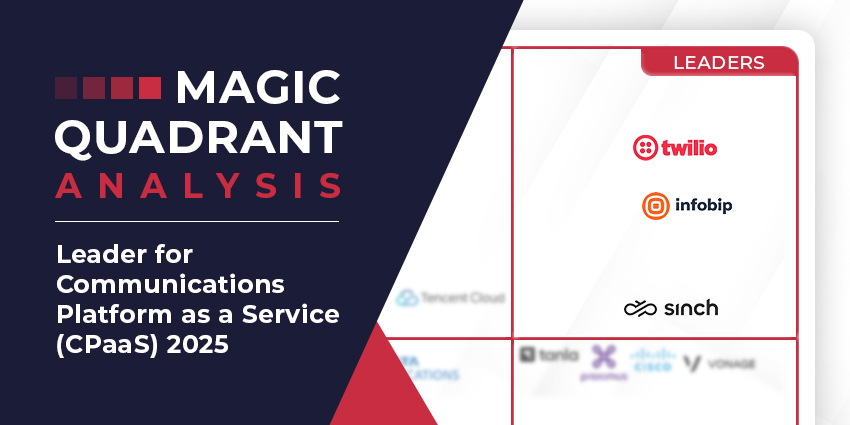Several trends are sweeping the CPaaS space. These include the convergence of CPaaS with other tech markets, new channels (like RCS), and a little something called agentic AI.
Amidst these market shifts, Twilio, Infobip, and Sinch stand firm as Gartner’s market Leaders.
However, Vonage has slipped out of the Leader quadrant, despite key differentiators in its network APIs, strong adjacent portfolio, and distinguished AI lab.
Vonage now sits in the Visionary square, alongside Cisco, Tanla, and newcomer Proximus Global, which merged last year with BICS, Telesign, and previous participant Route Mobile.
However, those are the only significant changes since 2024, with Tencent Cloud and Bandwidth remaining Challengers, while Tata Communications and Mitto still Niche Players.
Surprise omissions from the report include 8×8, GMS, and Syniverse. Meanwhile, tech giants like AWS and Microsoft ACS don’t feature.
The Definition of Communications Platform as a Service (CPaaS)
A CPaaS platform comprises three “types” of technology: integrations, communication channels, and workflow orchestration.
The workflow orchestration allows companies to define processes that take signals from integrated systems and translate those into actions across communication channels.
As such, while many companies may use CPaaS platforms to embed communications into enterprise apps, such solutions have many other use cases.
For instance, CPaaS may support customer experiences by enabling proactive communications, two-factor authentication, and custom routing.
Ultimately, it’s a cloud toolkit for multimodal conversations, which is why it’s converging with many CCaaS, CDP, and UCaaS solutions, alongside other enterprise technologies.
While Gartner offers a different definition, that’s essentially what each participant in this year’s study does.
In its evaluation, the research firm analyzes 11 prominent CPaaS providers and divides them into four quadrants: Leaders, Challengers, Visionaries, and Niche Players. Here’s how they performed.
Gartner Magic Quadrant Leaders
Leaders in the Magic Quadrant shape the market’s direction, with a compelling vision for CPaaS across use cases alongside a proven ability to drive business results. This year’s Leaders are:
- Twilio
- Infobip
- Sinch
Twilio
Twilio helped define the CPaaS market and has led it ever since. Indeed, its Communications portfolio continues to grow with global RCS, new authentication tools, and Conversational Relay.
Conversational Relay equips developers with tools to enable more natural voice interactions. It exemplifies how Twilio is merging CPaaS with conversational AI innovation.
Gartner isolates this as a strength, alongside its “rich developer ecosystem” and ability to combine data insights, AI, and omnichannel. As Twilio pulls its Communications and Segment businesses closer, that ability should continue to blossom.
Infobip
Infobip often attracts enterprises short on developers, with a solutions-focused go-to-market that allows it to sell results, not tricky terminology, like “CPaaS” itself.
Gartner also recognizes GenAI-enabled use cases and multimodal technologies as strengths, evident in the recent release of the Tencent Cloud Super App as a Service (TCSAS) solution.
Additional strengths Gartner highlights include its close customer relationships and responsive, “reliable” support teams.
Sinch
Sinch has a diverse CPaaS portfolio, including customer engagement applications, a developer API platform, and a “Super Network” for voice.
However, it bolsters all this with extensive direct support and a global partner base, which enables its customers to scale and realize ROI quickly.
Gartner lauds this, alongside Sinch’s “strong account management service” and “wide range of communication channels”, with the latter established via acquisitions and internal development.
Gartner Magic Quadrant Challengers
Challengers in the Magic Quadrant have developed a global footprint and reputations for delivering solutions that meet customer expectations across several specific use cases. They may, however, lack the vision and portfolio depth of Leaders. This year’s Challengers are:
- Tencent Cloud
- Bandwidth
Tencent Cloud
While most of its customers are pegged to China, Tencent Cloud earns plaudits for its channel strategy, which includes support for RCS in 15 countries.
Gartner also recognizes GenAI-enabled use cases and multimodal technologies as strengths, with the latter bolstered by the recent release of the Tencent Cloud Super App as a Service (TCSAS) solution.
However, alongside its limited geographic presence, Gartner warns that some customers have raised concerns around its pricing and technical support.
Bandwidth
In 2023, Bandwidth launched Maestro to blend leading CCaaS, UCaaS, and conversational AI solutions with its CPaaS stack to deliver deep, customized enterprise communications platforms.
Gartner recognized Bandwidth’s partnerships in these adjacent categories and Maestro’s orchestration engine as core strengths. The analyst also praised its network resiliency.
However, it warns that Bandwidth lacks advanced capabilities in video, commerce, and over-the-top (OTT) applications, limiting its suitability across several use cases.
Gartner Magic Quadrant Visionaries
Visionaries in the Magic Quadrant excel in their innovation, delivering differentiated solutions for specific customer segments. However, they may trail Leaders in their large customer support services and brand awareness. This year’s Visionaries are:
- Vonage
- Cisco
- Proximus Global
- Tanla
Vonage
Vonage differentiates via its 5G network APIs, supported by its parent company Ericsson, allowing developers to build more mobile communications solutions.
While Gartner doesn’t mention this, it praises Vonage’s vertical strategy, alongside its continued investment in innovation and regional technical support teams.
However, the analyst cites Vonage’s decision to scale back its activities in particular geographies as a significant concern for many customers, which could be why the vendor has lost its Leader status.
Cisco
Cisco moved into the CPaaS space in 2021, acquiring IMImobile. Since it has placed CPaaS at the back-end of its UCaaS and CCaaS solutions, delivering an advanced enterprise communications suite.
Gartner applauds these integrations, particularly between CPaaS and CCaaS, enabling greater cloud contact center customization, differentiated support experiences, and proactive customer service. It also commends Cisco’s vertical strategy and Visual Flow Builder.
However, the analyst also cited concerns that Cisco Webex Connect adoption is tied to North America and the UK. It’s also more focused on enterprises and “not tuned to developers or ISVs.”
Proximus Global
In December 2024, Proximus merged with BICS, Telesign, and Route Mobile to become Proximus Global, complete with a strong “global network backbone” and pooled capabilities.
Gartner isolates this unified, worldwide market approach as a strength, alongside its authentication capabilities and “developer-friendly community” that complements Route Mobile’s assets.
Yet, the research firm does warn that the merger of European, American, and Indian companies could cause shorter-term problems in managing systems, cultures, and pricing strategies.
Tanla
Tanla innovates quickly, with a broad portfolio crossing customer messaging, conversational commerce, and marketing automation. It’s also highly-regarded for its “user-friendly” interface.
Gartner didn’t highlight these advantages, but did note its partnerships with Google and Meta, AI-engagement tooling, and security solutions as key strengths.
Nevertheless, its limited presence beyond India and often drawn-out sales experience are among the cautions that the analyst raises.
Gartner Magic Quadrant Niche Players
Niche Players in the Magic Quadrant might offer capabilities ideal for specific customers. Nevertheless, several factors prevent them from competing for the biggest deals, such as portfolio depth, global support, and financial viability. This year’s Niche Players are:
- Tata Communications
- Mitto
Tata Communications
Tata Communications is a global services provider, allowing it to take a more consultative approach to enterprise CPaaS. Its portfolio also includes standout features, like number masking, video commerce, and voice marketing programs.
However, Gartner instead identifies its “programmable APIs for advanced use cases”, global coverage, and efforts to converge CCaaS and CPaaS as strengths.
Meanwhile, it cautions as to Tata’s muted presence in IT vendor marketplaces and “slow service and support”, citing verified customers on the latter.
Mitto
Given the absence of bigger CPaaS brands, Mitto is a surprise inclusion. Yet, Gartner justifies it by citing the vendor’s “networking, scalability, and cost-effectiveness”.
These strengths align with multinational brands that handle many engagements, as does its “differentiation lies in its proactively monitored AI-enabled intelligent routing.”
However, multinational brands will typically align with bigger-name brands, which is an issue with the analyst pointing to Mitto’s low market visibility.
For more rundowns of Gartner’s Magic Quadrant reports, check out our coverage of the:
- Gartner Magic Quadrant for Customer Data Platforms (CDPs) 2025
- Gartner Magic Quadrant for Contact Center as a Service (CCaaS) 2024
- Gartner Magic Quadrant for CRM Customer Engagement Center (CEC) 2024







